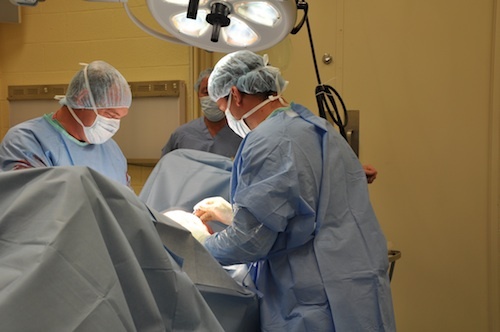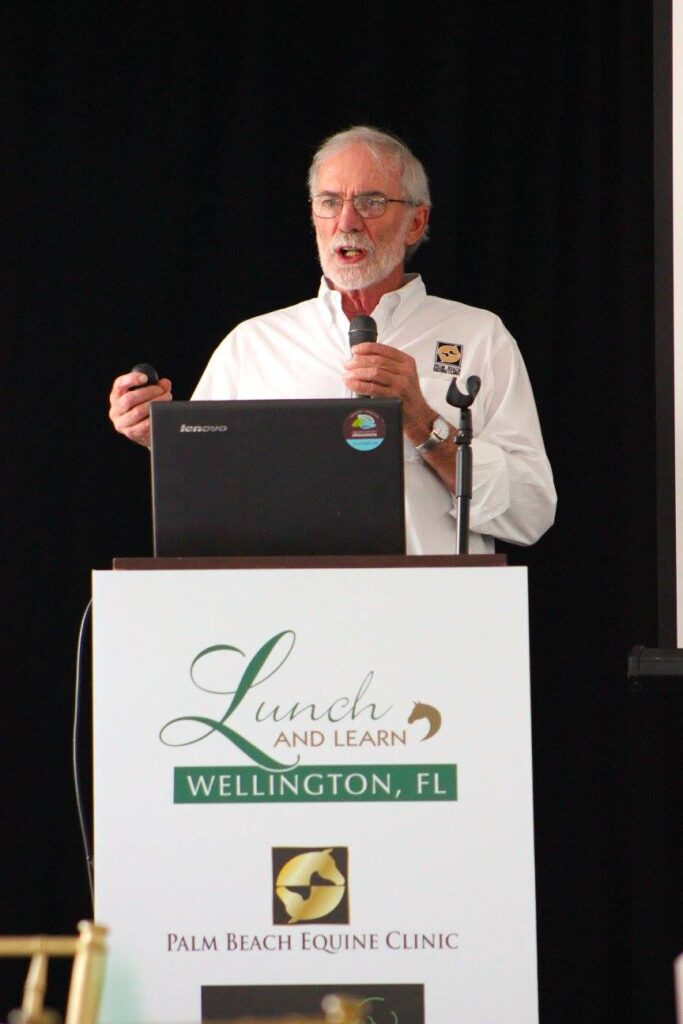Tag: brusie
Bella Ciao: Back Out Front

Racehorse Bella Ciao Undergoes Surgical Repair
Trainers Alessandro and Antonio Sano reviewed a daunting x-ray on the morning of April 19, 2019. Their three-year-old Thoroughbred filly Bella Ciao, owned by Cairoli Racing Stable and Magic Stables LLC, had just finished a breeze in 49 seconds flat when she suffered a fracture in her right front leg.
She exited the track at Gulfstream Park West, her home racecourse in Miami Gardens, FL, with her racing fate hanging in the balance.
“She is a tough filly with a lot of heart, and she walked herself back to the barn where we had x-rays taken,” said Alessandro, who met with the track veterinarian right away to identify the problem. “When we saw it, we were nervous that she was headed to the breeding shed, and her career was over.”
Alessandro and his father, however, were not willing to give up on their special filly. They entrust Palm Beach Equine Clinic’s board-certified surgeon, Dr. Robert Brusie, with care of their entire string of racehorses, and quickly decided to send the x-rays for his review. Dr. Brusie quickly identified a condylar fracture and advised a surgical repair. Immediately after her diagnosis was confirmed, Bella Ciao made her way to the Hospital at Palm Beach Equine Clinic.
Identifying a Condylar Fracture
A condylar fracture is a repetitive strain injury that results in a fracture to the cannon bone above the fetlock. The fracture is a result of excessive strain and weight carried over the cannon bone during high-speed exercise. It emerges from the fetlock joint running laterally up or medially out the side of the cannon bone, essentially breaking off a corner of the bone.
“A condylar fracture is a disease of speed,” said Dr. Brusie. “A condylar fracture was once considered the death of racehorses. As time and science progressed, it came to be considered merely career-ending. Currently, veterinary medical sciences are so advanced that we have had great success with condylar fracture patients returning to full work.
“Luckily, with today’s advanced rehabilitation services, time, and help from mother nature, many horses can come back from an injury like this. My prognosis for Bella Ciao after surgery was very good,” said Dr. Brusie.
Dr. Brusie performed Bella Ciao’s surgery and inserted five screws to repair the fracture.
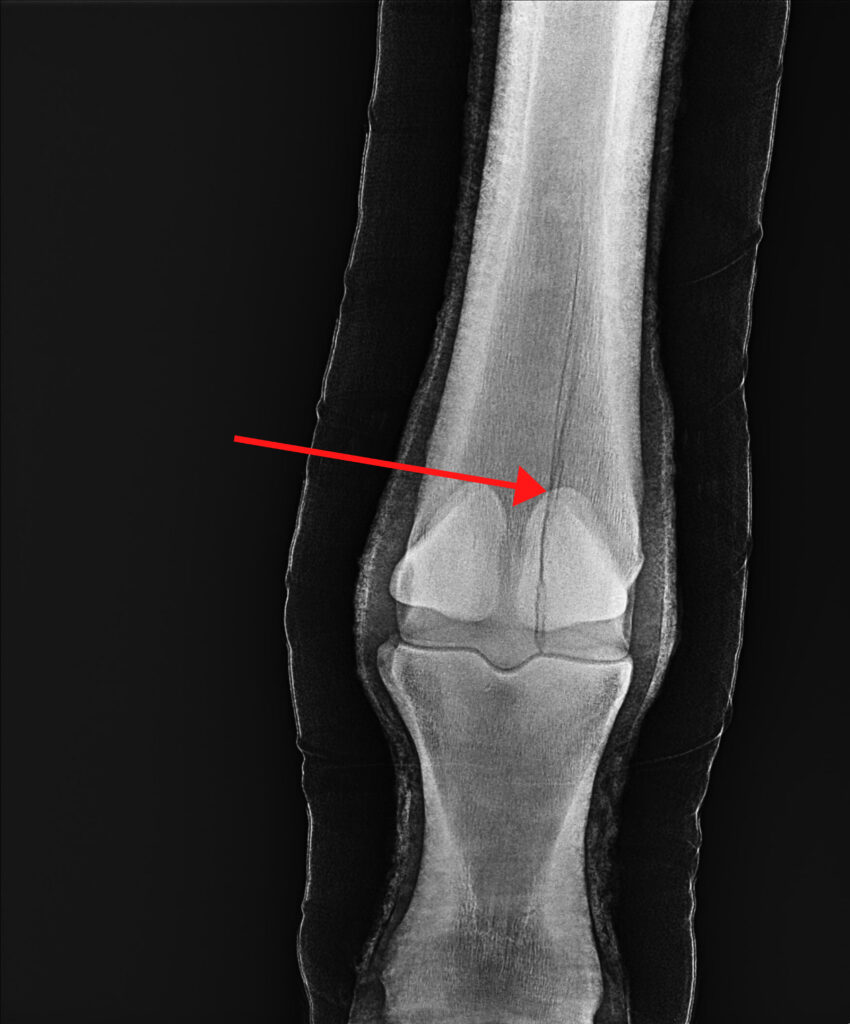

From left to right: Digital radiographs show the condylar fracture to the right front leg, and the five screws that completed the surgery.
“He does an excellent job with all of our horses. We wanted to give it a shot for Bella Ciao, and it paid off,” said Alessandro. He and his father, Antonio, have worked with Dr. Brusie on many horses, including a past Kentucky Derby runner and horses winning in excess of million-dollar purses. “He told us that she would be back to the track, so we followed his instructions perfectly.”
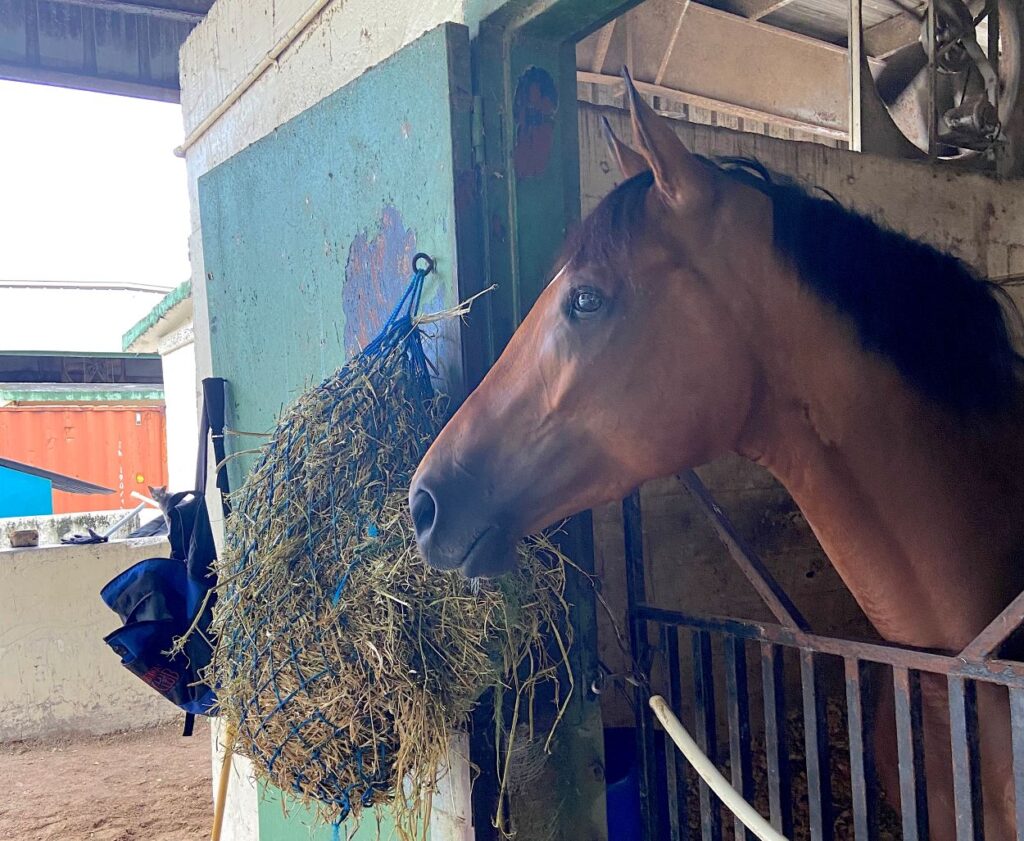
Back On Track
Dr. Brusie prescribed stall rest and hand walking for the first several months of Bella Ciao’s recovery. She slowly began jogging, and then breezing.
On October 27, 2019, she returned to the track in a $45,000 Allowance race. With Leonel Reyes up in the irons, Bella Ciao made her comeback in storybook fashion by winning that race and coming out fit, sound, and healthy. Now a four-year-old, Bella Ciao won again on April 30, 2020, and most recently placed third in a $60,000 race on June 27.
“While treatable, a condylar fracture is not an easy injury to come back from, but Dr. Brusie is one of the best surgeons in the country, and we trusted him,” said Alessandro, who has been working with Dr. Brusie since he and his father moved their business from Venezuela to the U.S. in 2010. “She recovered brilliantly, and we could not be happier with how she is going now. She is a special filly, and we are thrilled that we took this chance on her.”
When the Bone Breaks
Palm Beach Equine Clinic is Changing the Prognosis for Condylar Fracture Injuries
Palm Beach Equine Clinic is changing the prognosis for condylar fracture injuries in race and sport horses. Advances in diagnostic imaging, surgical skillset, and the facilities necessary to quickly diagnose, treat, repair, and rehabilitate horses with condylar fractures have improved dramatically in recent years.

Photo by Jump Media
Most commonly seen in Thoroughbred racehorses and polo ponies, a condylar fracture was once considered a career-ending injury. Today, however, many horses fully recover and return to competing in their respective disciplines.
What is a Condylar Fracture?
A condylar fracture is a repetitive concussive injury that results in a fracture to the cannon bone above the fetlock due to large loads transmitted over the cannon bone during high-speed exercise. On a radiograph, a condylar fracture appears as a crack that goes laterally up the cannon from the fetlock joint and out the side of the bone, essentially breaking off a corner of the cannon bone, sometimes up to six inches long.

“A condylar fracture is a disease of speed,” said Dr. Robert Brusie, a surgeon at Palm Beach Equine Clinic who estimates that he repairs between 30 and 50 condylar fractures per year. “A fracture to the left lateral forelimb is most common in racehorses as they turn around the track on a weakened bone and increased loading.”

Condylar fractures are further categorized into incomplete and non-displaced (the bone fragment hasn’t broken away from the cannon bone and is still in its original position), or complete and displaced (the fragment has moved away from the cannon bone itself and can often be visible under the skin).
Additionally, condylar fractures can occur laterally or medially. According to fellow Palm Beach Equine Clinic surgeon Dr. Weston Davis, most condylar fractures tend to be lateral on the outside condyle (a rounded projection on a bone, usually for articulation with another bone similar to a knuckle or joint).
“Most lateral condylar fractures are successfully repaired,” said Dr. Davis. “Medial condylar fractures tend to be more complicated configurations because they often spiral up the leg. Those require more advanced imaging and more advanced techniques to fix.”
What is the Treatment?
The first step in effectively treating a condylar fracture through surgery is to accurately and quickly identify the problem. Board-certified radiologist Dr. Sarah Puchalski utilizes the advanced imaging services at Palm Beach Equine Clinic to accomplish exactly this.
“Stress remodeling can be detected early and easily on nuclear scintigraphy before the horse goes lame or develops a fracture,” said Dr. Puchalski. “Early diagnosis of stress remodeling allows the horse to be removed from active race training and then return to full function earlier. Early diagnosis of an actual fracture allows for repair while the fracture is small and hopefully non-displaced.”

Photo by Jump Media
Once the injury is identified as a condylar fracture, Palm Beach Equine Clinic surgeons step in to repair the fracture and start the horse on the road to recovery. Depending on surgeon preference, condylar fracture repairs can be performed with the horse under general anesthesia, or while standing under local anesthesia. During either process, surgical leg screws are used to reconnect the fractured condyle with the cannon bone.
“For a small non-displaced fracture, we would just put in one to two screws across the fracture,” explains Dr. Davis. “The technical term is to do it in ‘lag fashion,’ such that we tighten the screws down heavily and really compress the fracture line. A lot of times the fracture line is no longer visible in x-rays after it is surgically compressed. When you get that degree of compression, the fractures heal very quickly and nicely.”
More complicated fractures, or fractures that are fully displaced, may require additional screws to align the parts of the bone. For the most severe cases of condylar fractures, a locking compression plate with screws is used to stabilize and repair the bone.
Palm Beach Equine Clinic surgeon Dr. Jorge Gomez approaches a non-displaced condylar fracture while the horse is standing, which does not require general anesthesia.

“I will just sedate the horse and block above the site of the fracture,” said Dr. Gomez. “Amazingly, horses tolerate it really well. Our goal is always to have the best result for the horse, trainers, and us as veterinarians.”
According to Dr. Gomez, the recovery time required after a standing condylar fracture repair is only 90 days. This is made even easier thanks to a state-of-the-art standing surgical suite at Palm Beach Equine Clinic. The four-and-a-half-foot recessed area allows doctors to perform surgeries anywhere ventral of the carpus on front legs and hocks on hind legs from a standing position. Horses can forgo general anesthesia for a mild sedative and local nerve blocks, greatly improving surgical recovery.
“A condylar fracture was once considered the death of racehorses, and as time and science progressed, it was considered career-ending,” concluded Dr. Brusie. “Currently, veterinary medical sciences are so advanced that we have had great success with condylar fracture patients returning to full work. Luckily, with today’s advanced rehabilitation services, time, and help from mother nature, many horses can come back from an injury like this.”
When dressage rider Meagan Davis and owner Scott Durkin think about the goals they have for their dressage horse Royale, they have tunnel vision for the grand prix ring. Royale, a 16-year-old Oldenburg gelding (Routinier x Ironman) was well on his way to accomplishing that goal during the 2019 season when something strange started happening.
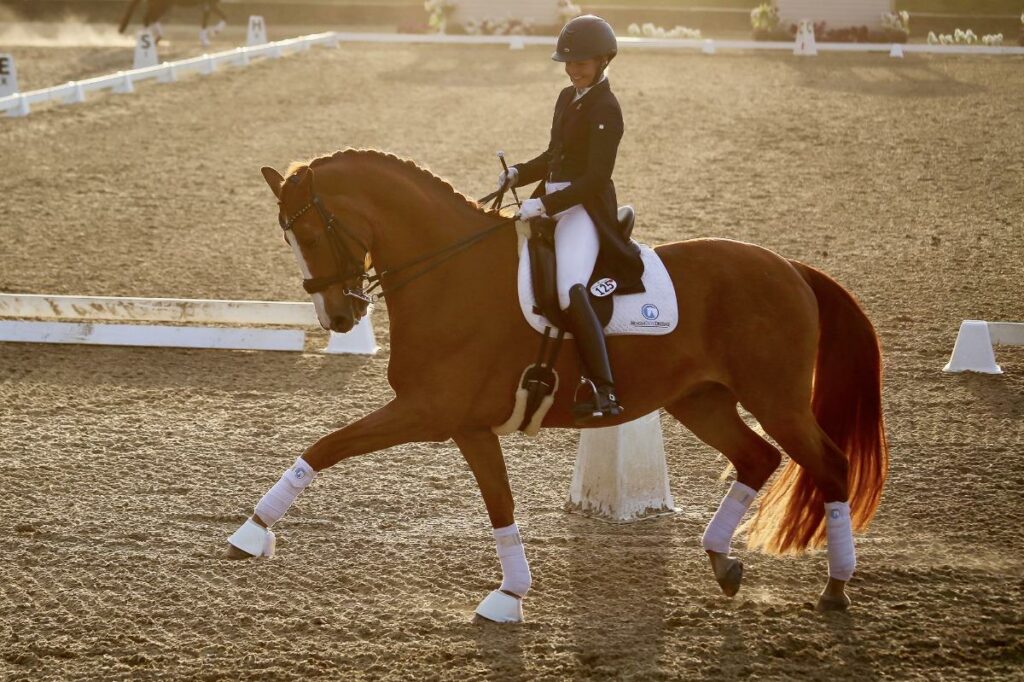
Photo courtesy of Meagan Davis
After arriving at their winter home in Loxahatchee, FL, from a northern base in Stone Ridge, NY, Davis kicked off Royale’s winter competition schedule with a show in January. The horse was coming off a very successful fall season that included CDI Intermediaire I and CDI Prix St. Georges victories at the New England Dressage Fall Festival and Dressage at Devon.
“Our first show was unusually chilly and I noticed that Royale was breathing a little hard and didn’t sweat very much,” recalled Davis. “I didn’t think that much of it because of the weather, but when we returned home and it warmed up, he wasn’t sweating at all.
“He could not catch his breath after being perfectly fit a month before,” continued Davis. “I rely on Palm Beach Equine Clinic for the care of all the horses in my barn and I immediately turned to Dr. Robert Brusie.”
Dr. Brusie is a Board-Certified Surgeon at Palm Beach Equine Clinic and was diligent about ruling out any physical causes of Royale’s obvious discomfort and decline in performance. After flexion tests, checking for musculoskeletal problems, and assessing soreness or wear and tear, Dr. Brusie turned to Palm Beach Equine Clinic’s Internal Medicine Specialist Dr. Peter Heidmann.
“Dr. Brusie was watching me work him one day, noticed the decline in muscle, the lack of sweating, and labored breathing, and recommended we take a deeper look with a specialist,” said Davis. “That is why I trust Palm Beach Equine Clinic with the care of my horses. They have so many tricks up their sleeves, and their clients are fortunate that the veterinarians collaborate so well together in order to do what’s best for the horse.”
Dr. Heidmann’s first step was to asses any neurological causes by testing for equine protozoal myeloencephalitis (EPM) and Lyme disease. Both were negative. He then moved on to a nutrient analysis.
“When you see weakness and poor muscle mass in a horse, two of the things you test for right away are vitamin E and selenium deficiencies,” said Dr. Heidmann. “Both are common causes of decreased performance due to low concentrations in local soil or the soil where a horse’s hay derives from.”
No deficiencies were found in Royale, which prompted Dr. Heidmann to move on to muscle testing. He drew blood from Royale, put him in work, and then drew blood again four to six hours later. When comparing enzymes in the blood from before and after work, Dr. Heidmann looked for any large increase, which would indicate the problem was in the muscles themselves. Royale’s tests, once again, came back normal.
At this point, Dr. Heidmann returned to the case history and started following the shortness of breath symptom, noting, “Breathing abnormalities in horses are difficult to diagnose by simply listening because their chest wall is so thick. What I wanted to asses was prolonged recovery. This is done by placing a bag over a horse’s nose to get them to breathe deeply. Once the bag is removed, breathing should regulate within two to three breaths. Royale needed four to five breaths.”
Once Dr. Heidmann identified a possible cause, he performed abronchoalveolar lavage (BAL), which is essentially a lung sample used to identify abnormal cells. He inserted a small-diameter tube through the trachea, flushed saline into the lung, and then suctioned it back out.
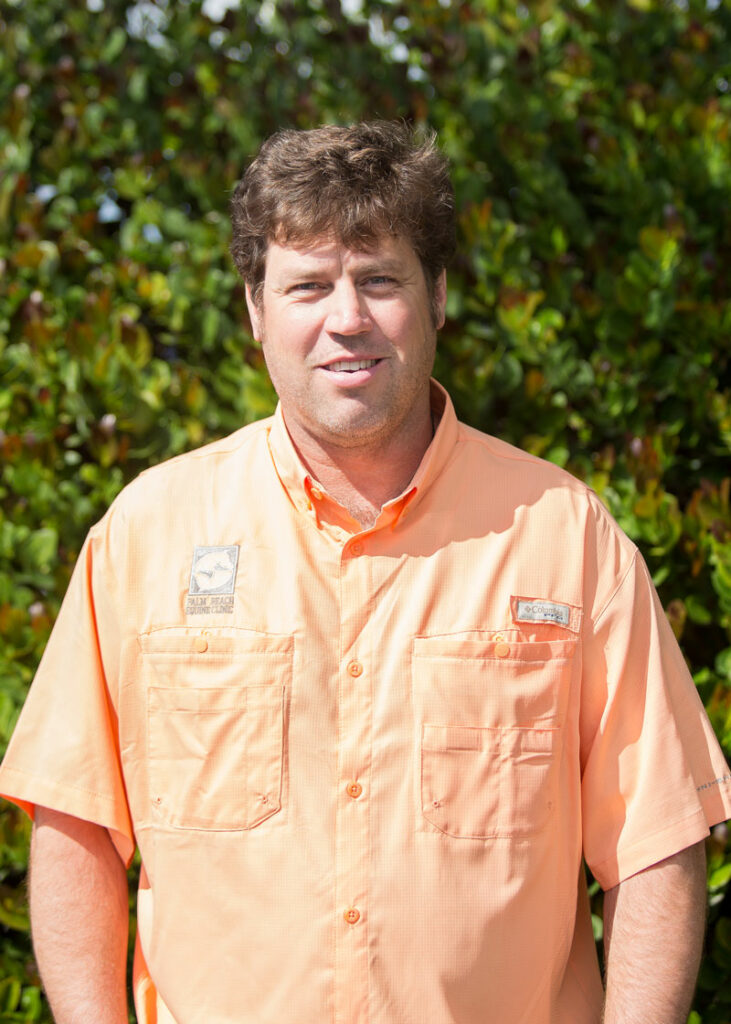
“Sure enough, when I examined the sample, there was mucus and abnormal cells,” said Dr. Heidmann. “Despite his bloodwork being normal and no obvious infections, Royale was battling equine asthma or ‘heaves.’”
The treatment for asthma in horses is very similar to what’s done for humans and includes an anti-inflammatory bronchodilator drug and inhaled steroids.
“While his breathing issues were significant enough to affect performance, Royale’s treatments were relatively mild with immediate and substantial improvement,” said Dr. Heidmann. “I used nebulized herbal remedies, steam, and Ventipulmin, which is an oral syrup.
“I’m a less-is-more person and veterinarian,” he continued. “I try to have the best outcome with the least amount of medications. Additionally, we created some routines that would minimize environmental dust and allergens, such as using a hay net, wetting down hay and bedding, or using chopped newspaper as bedding.”
Royale stayed on the prescribed medication through his trip home to New York and came off them at the end of May. Today, he is back in work and has regained the fitness and muscle he had during the fall. According to Davis, their goal is to step into the grand prix ranks during the upcoming season.
“My favorite cases are the sickest of the sick and the most elusive needle in a haystack,” concluded Dr. Heidmann. “Royale’s case definitely fell into the latter. It was really challenging, but rewarding because the outcome was a horse that is dramatically different than he was four months ago. But the most important part of this case for me was working together with Dr. Brusie. I would have not been successful in helping this horse if he hadn’t done all the work prior to coming to me. That kind of collaboration is what contributes to our success and sets Palm Beach Equine Clinic apart!”
Palm Beach Equine Clinic’s surgical team leader, Dr. Robert Brusie, is a nationally renowned board-certified surgeon whose surgical specialties include orthopedic, arthroscopic, and emergency cases. Dr. Brusie has been the head surgeon with Palm Beach Equine Clinic for the last 20 years and is a beloved part of the team.
Dr. Brusie graduated from Michigan State University (MSU) College of Veterinary Medicine. He completed his surgical residency at the Marion DuPont Scott Equine Center in Virginia in 1989 and has been in private practice ever since. He became a Diplomate of the American College of Veterinary Surgeons in 1994. Dr. Brusie joined the Palm Beach Equine Clinic team in 1996.
Board-certified surgeon, Dr. Brusie is recognized for his expertise in colic surgery, as well as for his skill in arthroscopic surgery. His surgical experience expands the clinic’s progressive care in both emergency and elective procedures. He has published articles on numerous topics, including the equine intestinal tract and septic arthritis in horses. Dr. Brusie is married and has three daughters. Read on to find out more about Dr. Brusie!
What is your background with horses?
I grew up on a farm in Michigan. We had usually between 200 and 600 head of cattle and always between four to six horses. Our horses were cow ponies or driving horses. My dad loved horses and had to have them around. My family has owned our farm for six generations and it pretty much occupied all of our time besides sports and school. Needless to say, we didn’t have much time to show horses.
When and why did you decide to become a veterinarian? Did you know you wanted to be a surgeon from the start?
I decided to become a veterinarian at an early age. I think I was seven or eight years old when I pulled my first calf. One of my dad’s hired men called me “Doc” when I was about that age. When I went to college, my plan was to become a large animal veterinarian and live in my hometown and continue to farm part-time with my three brothers. All of that changed when I was in veterinary school at MSU. Dr. Ed Scott was one of the five surgeons there; he was a gifted surgeon and a great teacher. He steered me into an equine internship at Auburn University. It was one of those things that the more you did, the more you wanted to do to improve yourself. I operated on my first colic by myself when I was three weeks out of vet school (32 years ago).
How did you first start working at Palm Beach Equine Clinic?
I was a surgeon at a clinic in Atlanta, and in 1996 I had performed a surgery for a client of Dr. Paul Wollenman’s. He had started this practice in 1975 and asked me if I needed a job. I was planning on staying in Atlanta for the rest of my career. I received phone calls from the other two partners over the next nine months, and eventually with encouragement from my fiancé, now wife, Melissa, I took the job.
What do you love most about working at Palm Beach Equine Clinic?
We have an exceptional group of veterinarians and staff here. The depth and scope of our veterinarians is amazing due to the large caseload. On any individual case, there may be two to three doctors that have input on the case to ensure no stone is left unturned. Additionally, we are so privileged to work on some of the best show, race, and polo horses in the world. It is truly an honor.
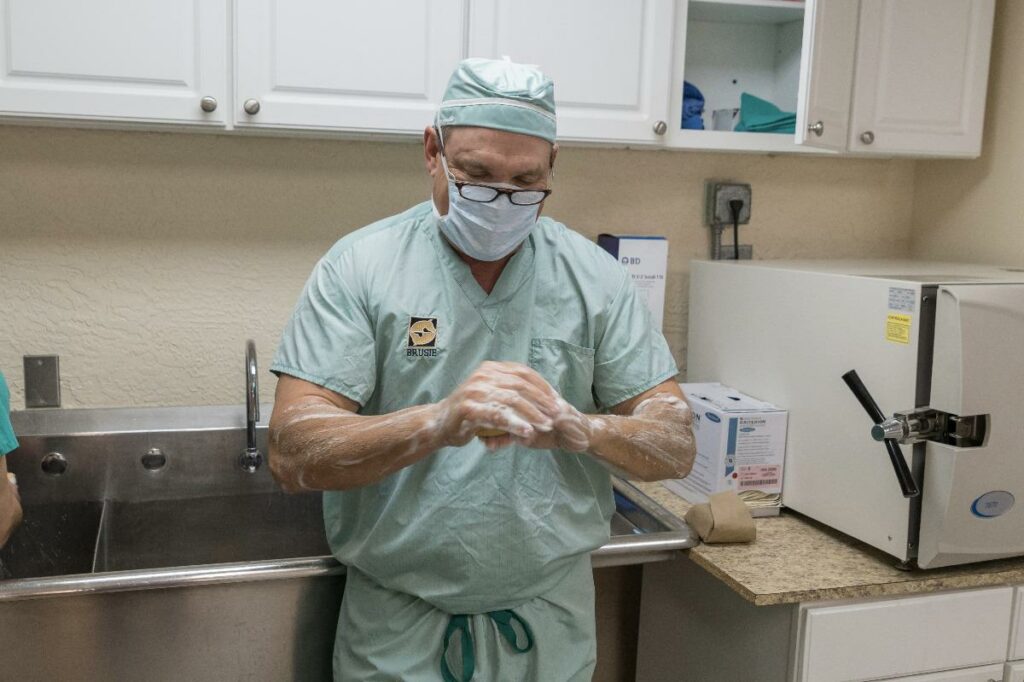
What sets the surgical services at Palm Beach Equine Clinic apart?
Between Dr. Jorge Gomez, Dr. Weston Davis, and myself, we perform just about every type of soft tissue and orthopedic surgeries that are done in our field. Personally, my greatest sense of success is when I see a horse back after surgery going as well or better than it was prior to surgery.
What are the biggest changes you have seen in sport horse medicine over the years?
Currently, the most exciting thing we see going on in medicine is regenerative therapy. Twelve to 15 years ago, we were harvesting bone marrow from the sternum and injecting it into lesions in tendons and ligaments. Now we manipulate the bone marrow or other sources of stem cells to promote more rapid and more functional healing of some of these injuries. I can assure you that in 10 to 20 years what we are doing now will seem stone-aged by then. There are some very clever minds performing some serious research in this field.
How do you stay up-to-date on new medical advances?
Every veterinarian at Palm Beach Equine Clinic tries to attend as many meetings as time allows. We also do a weekly journal club at our clinic to discuss recently published papers in veterinary and human medicine and surgery.
What is the most interesting or challenging surgery that you have done?
Dr. Gomez and I had a three-year-old racehorse that had split his P1 (long pastern bone) and cannon bone in the same leg in a race. We were able to piece together both bones perfectly and the horse recovered brilliantly. He probably could have returned to racing, however, the owners elected to retire him to life as a breeding stallion.
What is something interesting that people may not know about you?
I have three daughters who I am very proud of and tend to brag on maybe a little too much.
How else is the family involved in horses?
My wife [Melissa] and youngest daughter [Kayla] are horse nuts in the true sense of the word. Anything to do with horses, especially show hunters, they are dialed in. Melissa loves riding, and Kayla shows in hunters and equitation.
What makes Palm Beach Equine Clinic a special place for you?
I am blessed to have three good men as business partners. They are my good friends and great people. We are very lucky to have 20-plus veterinarians working with us who are very knowledgeable and caring individuals. We feel like a little practice, but with a lot of people who just get the job done.
Palm Beach Equine Clinic (PBEC) is changing the prognosis for condylar fracture injuries among sport horses. Advances in imaging, surgical talent, and the facilities necessary to quickly diagnose, treat, repair, and rehabilitate horses with condylar fractures have recently improved immensely.
Most commonly seen in Thoroughbred racehorses and occasionally polo ponies, a condylar fracture was once considered a career-ending injury. Today, however, odds are in favor of a full recovery with horses regularly returning to competition in their respective disciplines.
What is a Condylar Fracture?

A condylar fracture is a repetitive strain injury that results in a fracture to the cannon bone above the fetlock due to large loads transmitted during high-speed exercise. 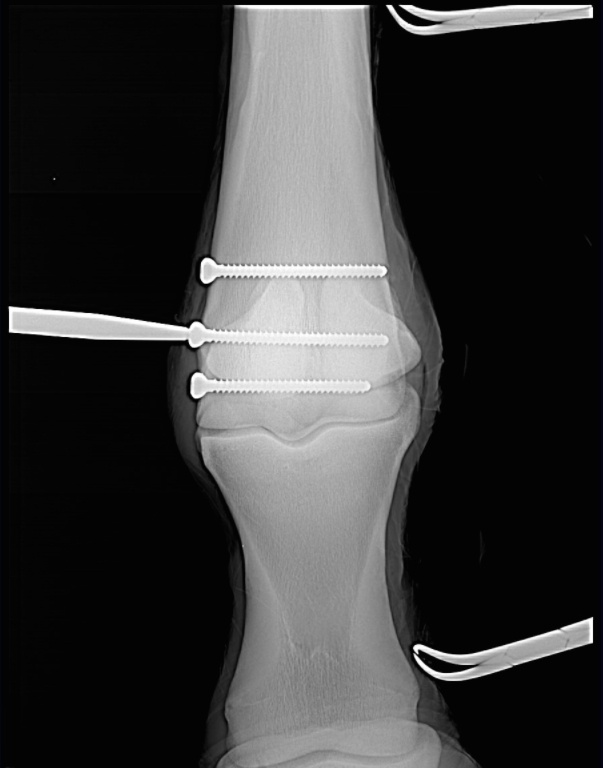
Scan showing the screws inserted during surgery (right). This patient, a Thoroughbred racehorse, walked away from surgery comfortably and is recovering well.
A condylar fracture is a repetitive strain injury that results in a fracture to the cannon bone above the fetlock due to large loads transmitted over the cannon bone during high-speed exercise. On a radiograph, a condylar fracture appears as a crack that goes laterally up the cannon from the fetlock joint and out the side of the bone, essentially breaking off a corner of the cannon bone, sometimes up to six inches long.
“A condylar fracture is a disease of speed,” said Dr. Robert Brusie, a surgeon at PBEC who estimates that he repairs between 30 and 50 condylar fractures per year. “A fracture to the left lateral forelimb is most common in racehorses as they turn around the track on a weakened bone and increased loading.”
Condylar fractures are further categorized into incomplete and non-displaced (the bone fragment hasn’t broken away from the cannon bone and is still in its original position), or complete and displaced (the fragment has moved away from the cannon bone itself and can often be visible under the skin).
Additionally, condylar fractures can occur laterally or medially. According to fellow PBEC surgeon Dr. Weston Davis, most condylar fractures tend to be lateral on the outside condyle (a rounded projection on a bone, usually for articulation with another bone similar to a knuckle or joint).
“Most lateral condylar fractures are fairly simple for us to fix,” said Dr. Davis. “Medial condylar fractures tend to be more complicated configurations because they often spiral up the leg. Those require more advanced imaging and more advanced techniques to fix.”
What is the Treatment?
The first step in effectively treating a condylar fracture through surgery is to accurately and quickly identify the problem. PBEC’s board-certified radiologist Dr. Sarah Puchalski utilizes the advanced imaging services at PBEC to accomplish exactly this.
“Stress remodeling can be detected early and easily on nuclear scintigraphy before the horse goes lame or develops a fracture,” said Dr. Puchalski. “Early diagnosis of stress remodeling allows the horse to be removed from active race training and then return to full function earlier. Early diagnosis of an actual fracture allows for repair while the fracture is small and hopefully non-displaced.”
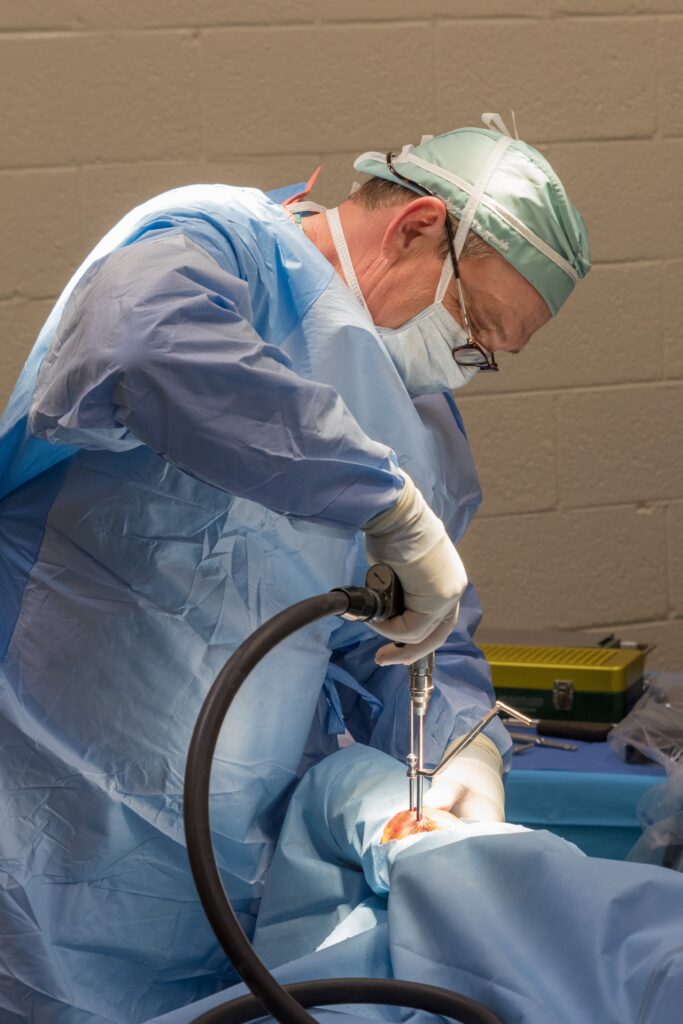
Once the injury is identified as a condylar fracture, PBEC surgeons step in to repair the fracture and start the horse on the road to recovery. Depending on surgeon preference, condylar fracture repairs can be performed with the horse under general anesthesia, or while standing under local anesthesia. During either process, surgical leg screws are used to reconnect the fractured condyle with the cannon bone.
“For a very simple and small non-displaced fracture, we would just put in one to two screws across the fracture,” explains Dr. Davis. “The technical term is to do it in ‘lag fashion,’ such that we tighten the screws down heavily and really compress the fracture line. A lot of times the fracture line is no longer visible in x-rays after it is surgically compressed. When you get that good compression, the fractures heal very quickly and nicely.”
More complicated fractures, or fractures that are fully displaced, may require more screws to align the parts of the bone. For the most severe cases of condylar fractures, a locking compression plate with screws is used to stabilize and repair the bone.
PBEC surgeon Dr. Jorge Gomez, approaches a simpler non-displaced condylar fracture while the horse is standing, which helps to aid in a faster recovery and more successful surgical outcome.
“I will just sedate the horse and block above the site of the fracture,” said Dr. Gomez. “Amazingly, horses tolerate it really well. Our goal is always to have the best result for the horse, trainers, and us as veterinarians.”
According to Dr. Gomez, the recovery time required after a standing condylar fracture repair is only 90 days. This is made even easier thanks to a state-of-the-art surgery pit installed at PBEC. The four-and-a-half-foot recessed area allows doctors to perform surgeries on anything from a horse’s hock and below from a standing position. Horses can forgo the risks of general anesthesia for a mild sedative and local nerve blocks, greatly improving outcomes.
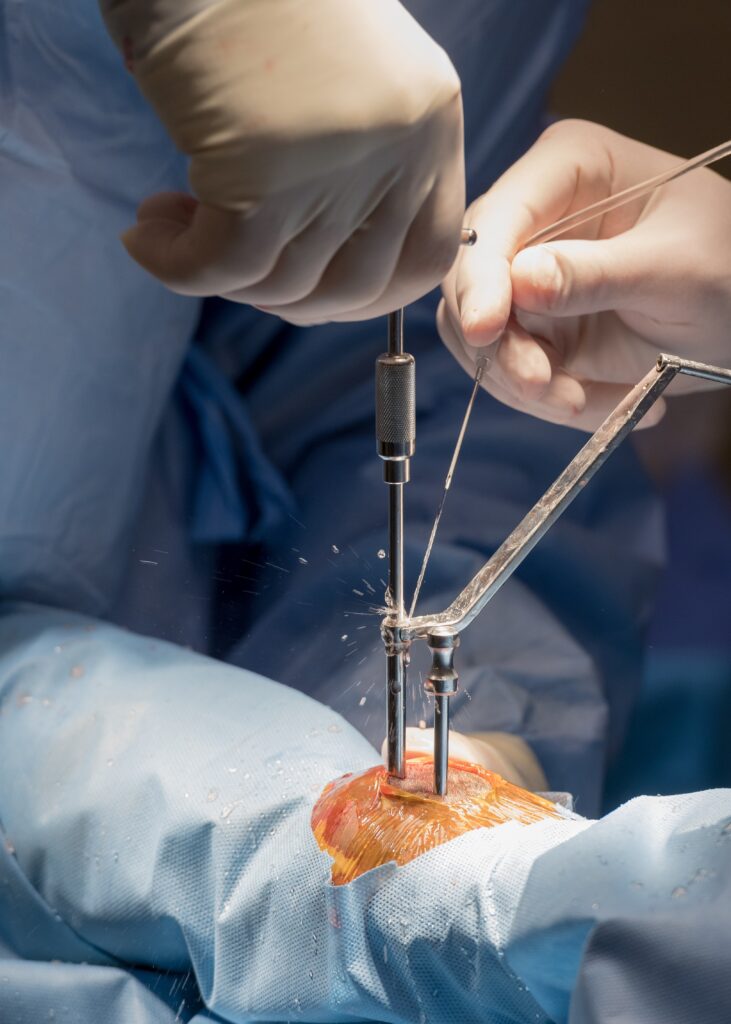
“A condylar fracture was once considered the death of racehorses, and as time and science progressed, it was considered career-ending,” concluded Dr. Brusie. “Currently, veterinary medical sciences are so advanced that we have had great success with condylar fracture patients returning to full work. Luckily, with today’s advanced rehabilitation services, time, and help from mother nature, many horses can come back from an injury like this.”
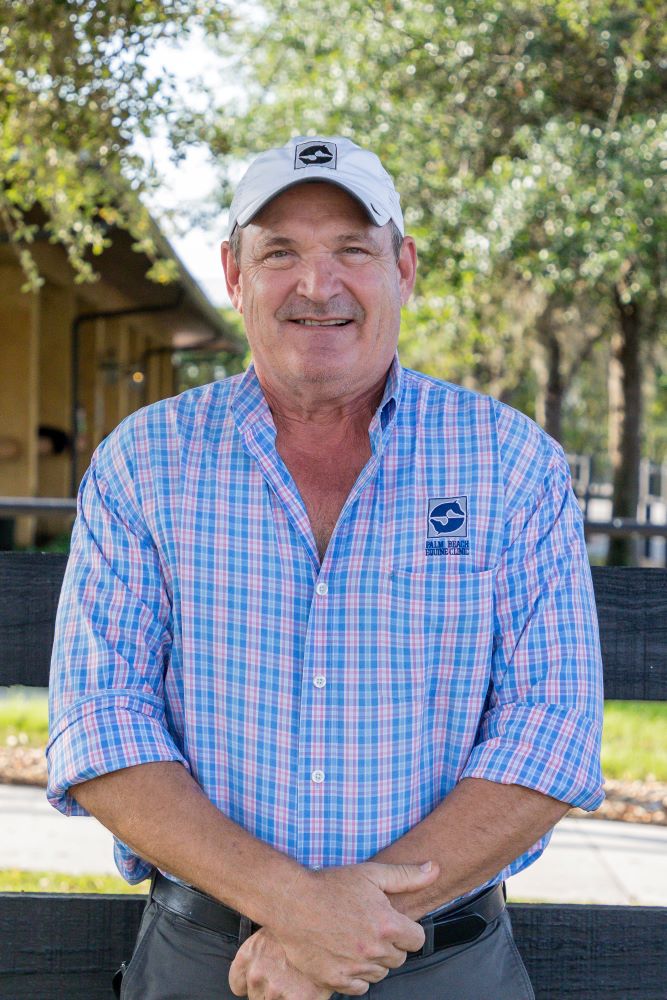
Palm Beach Equine Clinic of Wellington, FL, has a team of over 30 skilled veterinarians, including three Board-Certified Surgeons, one of the world’s only Board-Certified equine Radiologists, and numerous other experts in their fields. Palm Beach Equine Clinic’s surgical team leader, Dr. Robert Brusie, is a nationally renowned Board-Certified surgeon whose surgical specialties include orthopedic, arthroscopic, and emergency cases. Dr. Brusie has been the head surgeon with Palm Beach Equine Clinic for the past 20 years and is a beloved part of the team.
Dr. Brusie graduated from Michigan State University College of Veterinary Medicine. He completed his surgical residency at the Marion DuPont Scott Equine Center in 1989 and has been in private practice ever since. He became a Diplomate of the American College of Veterinary Surgeons in 1994. Dr. Brusie joined Palm Beach Equine Clinic in 1996.
Dr. Brusie is a Board-Certified Surgeon who is recognized for his expertise in colic surgery, as well as for his skill in arthroscopic surgery. His surgical experience expands the clinic’s progressive care in both emergency and elective procedures. He has published articles on numerous topics, including the equine intestinal tract and septic arthritis in horses. Dr. Brusie is married and has three daughters.
What was your background with horses growing up?
I grew up on a farm in Michigan. We had usually between 200-600 head of cattle and always between four to six horses. Our horses were cow ponies or driving horses. My dad loved horses and had to have them around. My family has owned our farm for six generations – it pretty much occupied all of our time besides sports and school. Needless to say, we didn’t have much time to show horses.
When and why did you decide to become a veterinarian? Did you know you wanted to be a surgeon from the start?
I decided to become a veterinarian at an early age. I think I was seven or eight years old when I pulled my first calf. One of my dad’s hired men called me ‘doc’ when I was about that age. When I went to college, my plan was to become a large animal veterinarian and live in my hometown and continue to farm part-time with my three brothers. All of that changed when I was in Veterinary school at Michigan State University. Dr. Ed Scott was one of the five surgeons at MSU. He was a gifted surgeon and a great teacher. He kind of steered me into an equine internship at Auburn University. It was one of those things that the more you did, the more you wanted to do to improve yourself. I operated my first colic by myself when I was three weeks out of vet school (32 years ago).
How did you first start working at Palm Beach Equine Clinic?

I was a surgeon at a clinic in Atlanta. In 1996 I had performed surgery for a client of Dr. Paul Wollenman’s. He had started this practice in 1975. He asked me if I needed a job. I was planning on staying in Atlanta for the rest of my career. I received phone calls from the other two partners over the next nine months, and eventually with encouragement from my fiancé, now wife Melissa, I took the job.
What do you love most about working at Palm Beach Equine Clinic?
We have an exceptional group of veterinarians and staff here. The depth and scope of our veterinarians is amazing due to the large caseload. On any individual case, there may be two to three doctors that have input on the case to ensure no stone is left unturned.
Additionally, we are so privileged to work on some of the best show, race, and polo horses in the world. It is truly an honor.
What sets the surgical services at Palm Beach Equine Clinic apart?
Between Drs. Gomez, Davis, and myself, we perform just about every soft tissue and orthopedic surgeries that are done in our field.
Personally, my greatest sense of success is when I see a horse back after surgery going as good or better than it was prior to surgery.
What are the biggest changes you have seen in sport horse medicine over the years?
Currently, the most exciting thing we see going on in medicine is regenerative therapy. Twelve to 15 years ago, we were harvesting bone marrow from the sternum and injecting it into lesions in tendons and ligaments. Now we manipulate the bone marrow or other sources of stem cells to promote more rapid and more functional healing of some of these injuries. I can assure you that in 10-20 years what we are doing now will seem stone-aged by then. There are some very clever minds performing some serious research in this field.
How do you stay up-to-date on new medical advances?
Every veterinarian at Palm Beach Equine Clinic tries to attend as many meetings as time allows. We also do a weekly journal club at our clinic to discuss recently published papers in veterinary and human medicine and surgery.
What is the most interesting or challenging surgery that you have done?
Dr. Gomez and I had a three-year-old racehorse that had split his P1 (long pastern bone) and cannon bone in the same leg in a race. We were able to piece together both bones perfectly and the horse recovered brilliantly. He probably could have returned to racing, however, the owners elected to retire him to life as a breeding sire.

How do you spend your free time when you are not working?
When I’m not doing something with my family, I really enjoy woodworking. My current project is building a kitchen table for Sarah, my assistant of 12 years. In the summer, I get roped into helping on my brother’s farm.
What is something interesting that people may not know about you?
I have three daughters who I am very proud of and tend to brag on maybe a little too much. My oldest, who was a nationally ranked swimmer, is now an anesthesiologist in human medicine. My middle one is either number four or five (depending on the week) in the nation in debate, and my youngest will probably run the free world (you will have to ask her if she wants to).
How else is the family involved in horses?
My wife (Melissa) and youngest daughter (Kayla) are horse nuts in the true sense of the word. Anything to do with horses (especially show hunters) they are dialed in. Melissa loves riding, and Kayla shows in hunters and equitation.
What makes Palm Beach Equine Clinic a special place for you?
I am blessed to have three good men as business partners. They are my good friends and great people. We are very lucky to have 20-plus veterinarians working with us who are very knowledgeable and caring individuals. We feel like a little practice, but with a lot of people who just get the job done.
Palm Beach Equine Clinic provides experience, knowledge, availability, and the very best care for its clients. Make Palm Beach Equine Clinic a part of your team!
Foot soreness, especially for jumpers, become more noticeable as the winter equestrian season winds down in Florida, according to well-respected veterinarian and farrier Dr. Stephen O’Grady of Palm Beach Equine Clinic.

Foot Soreness Issues Surfacing Toward the End of Winter Competition Season
Dr. O’Grady has been treating horses for 45 years across the country. He also travels extensively all over the world, teaching and training other veterinarians and farriers on therapeutic farriery solutions. It’s obvious to Dr. O’Grady why foot soreness and problems are more common later in the horse show season.
“When horses arrive in Wellington, Florida, in December, foot care starts with bar shoes, pads, pour-ins, etc. as a form of prevention for the busy three months. Perhaps it would be more appropriate to start the competition season by doing a conservative trim, leave horn on the bottom of the foot, and make sure the proper size shoe is selected. The various farrier products may actually add pressure to the structures in the beginning of the season” says Dr. O’Grady.
“When it comes around to March, the structures of the foot have been compromised by the intensity of the competition schedule. The protective farrier products have already been used and there’s nothing more to absorb the shock and energy at the end of the season.”
Preventing Foot Soreness in Competition Horses
Dr. O’Grady adds that it is okay to use different medications and anti-inflammatories as long as the proper dosages and rules are followed as prescribed. But to properly fix foot problems, he has one sure solution.
“Time is the best cure,” Dr. O’Grady says. “The feet are the slowest structures on the horse to recover. There isn’t a magical fix.”
However, Dr. O’Grady has an idea that might help if you cannot give your horse sufficient rest despite the numerous classes and repetitive nature of the show schedule.
As the season wears on, whether it’s WEF or HITS, Dr. O’Grady believes that decreasing the amount of warm up, schooling and lunging makes a world of difference in protecting the hooves.
“But if the feet are sore, the feet are sore,” adds Dr. O’Grady. “There’s no quick fix. It’s all about prevention.”
Snowballing Effects of Foot Soreness
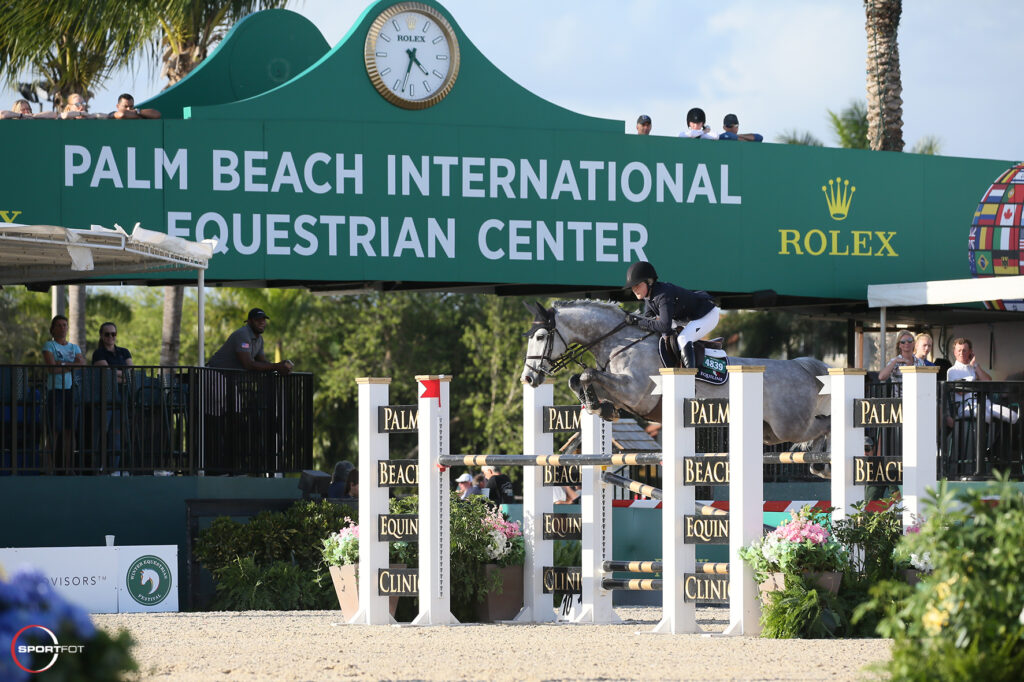
Sore feet can cause numerous problems elsewhere, according to Dr. Robert Brusie, head surgeon at Palm Beach Equine Clinic.
“The horses with sore feet tend to land funny, which can cause strained suspension ligaments or tendons,” says Dr. Brusie. “There also could be sore heels. Sore feet tend to make them short-strided and that could lead to a sore back and or a sore neck.”
Dr. Brusie says one way to notice a horse with sore feet, especially among jumpers, is their reluctance to jump the fences.
“That can be hard on the riders, too,” adds Dr. Brusie.
The foot is the closest to the environment and if you have a sore-footed horse, it could lead to lameness and poor performance, according to Dr. Brusie. Another possibility that could lead to sore feet is being too wet.
“Horses that are to show or play (polo) sometimes get two or three baths a day,” explains Dr. Brusie. Coupled with rings that are sprayed with water to help the footing can lead to problems, he said.
Both Dr. O’Grady and Dr. Brusie believe that taking proper care of your horse’s feet early helps the horses in the long run by eliminating other problems.
